Experimental Investigation of Cumulative Damage and Self-Healing Properties of Smart Cementitious Composite under Continuous Compression Load
Abstract
:1. Introduction
2. Experimental Program
2.1. Materials, Mix Proportions, and Mechanical Properties
2.2. Specimen Design and Preparation
2.3. Test Setup for Coupled Sustained Loading and Water Absorption
2.4. Loading and Testing Procedures
2.5. Estimation of Cumulative Water Absorption
3. Results and Discussion
3.1. Cumulative Water Content under Sustained Compressive Loading
3.2. Sorptivity under Sustained Compressive Loading
3.3. Cumulative Water Absorption before and after Damage
3.4. Self-Repairing Ability of SMA-ECC
4. Conclusions
Author Contributions
Funding
Institutional Review Board Statement
Informed Consent Statement
Data Availability Statement
Acknowledgments
Conflicts of Interest
References
- Al-Obaidi, S.; Davolio, M.; Monte, F.L.; Costanzi, F.; Luchini, M.; Bamonte, P.; Ferrara, L. Structural validation of geothermal water basins constructed with durability enhanced ultra high performance fiber reinforced concrete (Ultra High Durability Concrete). Case Stud. Constr. Mater. 2022, 17, e01202. [Google Scholar] [CrossRef]
- Guo, H.; Dong, Y. Dynamic Bayesian network for durability of reinforced concrete structures in long-term environmental exposures. Eng. Fail. Anal. 2022, 142, 106821. [Google Scholar] [CrossRef]
- Su, C.; Wang, X.; Ding, L.; Wu, Z.; Ma, X. Durability of seawater sea sand concrete beams reinforced with carbon nanotube-modified BFRP bars in a marine environment. Compos. Struct. 2022, 292, 115642. [Google Scholar] [CrossRef]
- Ramezanianpour, A.A.; Ghoreishian SA, H.; Ahmadi, B.; Balapour, M.; Ramezanianpour, A.M. Modeling of chloride ions penetration in cracked concrete structures exposed to marine environments. Struct. Concr. 2018, 19, 1460–1471. [Google Scholar] [CrossRef]
- Zhang, W.; Francois, R.; Cai, Y.; Charron, J.P.; Yu, L. Influence of artificial cracks and interfacial defects on the corrosion behavior of steel in concrete during corrosion initiation under a chloride environment. Constr. Build. Mater. 2020, 253, 119165. [Google Scholar] [CrossRef]
- AL-Ameeri, A.S.; Rafiq, M.I.; Tsioulou, O. Combined impact of carbonation and crack width on the Chloride Penetration and Corrosion Resistance of Concrete Structures. Cem. Concr. Compos. 2021, 115, 103819. [Google Scholar] [CrossRef]
- Lambert, P.; Page, C.L.; Vassie, P.R.W. Investigations of reinforcement corrosion. 2. Electrochemical monitoring of steel in chloride-contaminated concrete. Mater. Struct. 1991, 24, 351–358. [Google Scholar] [CrossRef]
- Maruya, T.; Hsu, K.; Takeda, H.; Tangtermsirikul, S. Numerical modeling of steel corrosion in concrete structures due to chloride ion, oxygen and water movement. J. Adv. Concr. Technol. 2003, 1, 147–160. [Google Scholar] [CrossRef]
- Ann, K.Y.; Song, H.W. Chloride threshold level for corrosion of steel in concrete. Corros. Sci. 2007, 49, 4113–4133. [Google Scholar] [CrossRef]
- Khan, M.U.; Ahmad, S.; Al-Gahtani, H.J. Chloride-induced corrosion of steel in concrete: An overview on chloride diffusion and prediction of corrosion initiation time. Int. J. Corros. 2017, 2017, 5819202. [Google Scholar] [CrossRef]
- Kiesse, T.S.; Bonnet, S.; Amiri, O.; Ventura, A. Analysis of corrosion risk due to chloride diffusion for concrete structures in marine environment. Mar. Struct. 2020, 73, 102804. [Google Scholar] [CrossRef]
- Liu, P.; Chen, Y.; Xing, F.; Yu, Z.; Wang, W.; Miao, L. Water transport behavior of concrete: Boundary condition and water influential depth. J. Mater. Civ. Eng. 2018, 30, 04018288. [Google Scholar] [CrossRef]
- Bao, J.; Li, S.; Zhang, P.; Xue, S.; Cui, Y.; Zhao, T. Influence of exposure environments and moisture content on water repellency of surface impregnation of cement-based materials. J. Mater. Res. Technol. 2020, 9, 12115–12125. [Google Scholar] [CrossRef]
- Bao, J.; Li, S.; Yu, Z.; Xu, J.; Li, Y.; Zhang, P.; Gao, S. Water transport in recycled aggregate concrete under sustained compressive loading: Experimental investigation and mesoscale numerical modelling. J. Build. Eng. 2021, 44, 103373. [Google Scholar] [CrossRef]
- Gao, Q.; Ma, Z.; Xiao, J.; Li, F. Effects of Imposed Damage on the Capillary Water Absorption of Recycled Aggregate Concrete. Adv. Mater. Sci. Eng. 2018, 2018, 2890931. [Google Scholar] [CrossRef]
- Wang, L.; Li, S. Capillary absorption of concrete after mechanical loading. Mag. Concr. Res. 2014, 66, 420–431. [Google Scholar] [CrossRef]
- Hanžič, L.; Kosec, L.; Anžel, I. Capillary absorption in concrete and the Lucas–Washburn equation. Cem. Concr. Compos. 2010, 32, 84–91. [Google Scholar] [CrossRef]
- Ali, M.A.E.M.; Soliman, A.M.; Nehdi, M.L. Hybrid-fiber reinforced engineered cementitious composite under tensile and impact loading. Mater. Des. 2017, 117, 139–149. [Google Scholar] [CrossRef]
- Min, H.; Zhang, W.; Gu, X. Effects of load damage on moisture transport and relative humidity response in concrete. Constr. Build. Mater. 2018, 169, 59–68. [Google Scholar] [CrossRef]
- Fu, C.; Ye, H.; Jin, N.; Huang, Y. Chloride penetration in reinforced concrete beams under combined sustained loading and drying–wetting cycles. J. Mater. Civ. Eng. 2020, 32, 04020025. [Google Scholar] [CrossRef]
- Liu, H.; Zhang, Q.; Gu, C.; Su, H.; Li, V. Self-healing of microcracks in Engineered Cementitious Composites under sulfate and chloride environment. Constr. Build. Mater. 2017, 153, 948–956. [Google Scholar] [CrossRef]
- Otieno, M.B.; Alexander, M.G.; Beushausen, H.D. Corrosion in cracked and uncracked concrete–influence of crack width, concrete quality and crack reopening. Mag. Concr. Res. 2010, 62, 393–404. [Google Scholar] [CrossRef]
- Vidal, T.; Castel, A.; François, R. Analyzing crack width to predict corrosion in reinforced concrete. Cem. Concr. Res. 2004, 34, 165–174. [Google Scholar] [CrossRef]
- Toohey, K.S.; Sottos, N.R.; Lewis, J.A.; Moore, J.S.; White, S.R. Self-healing materials with microvascular networks. Nat. Mater. 2007, 6, 581–585. [Google Scholar] [CrossRef]
- Blaiszik, B.J.; Kramer, S.L.B.; Olugebefola, S.C.; Moore, J.S.; Sottos, N.R.; White, S.R. Self-Healing Polymers and Composites. Annu. Rev. Mater. Res. 2010, 40, 179–211. [Google Scholar] [CrossRef]
- Jonkers, H.M.; Thijssen, A.; Muyzer, G.; Copuroglu, O.; Schlangen, E. Application of bacteria as self-healing agent for the development of sustainable concrete. Ecol. Eng. 2010, 36, 230–235. [Google Scholar] [CrossRef]
- Chen, W.; Lin, B.; Feng, K.; Cui, S.; Zhang, D. Effect of shape memory alloy fiber content and preloading level on the self-healing properties of smart cementitious composite (SMA-ECC). Constr. Build. Mater. 2022, 341, 127797. [Google Scholar] [CrossRef]
- Chen, W.; Feng, K.; Wang, Y.; Lin, Y.; Qian, H. Evaluation of self-healing performance of a smart composite material (SMA-ECC). Constr. Build. Mater. 2021, 290, 123216. [Google Scholar] [CrossRef]
- Bao, J.; Wang, L. Effect of short-term sustained uniaxial loadings on water absorption of concrete. J. Mater. Civ. Eng. 2017, 29, 04016234. [Google Scholar] [CrossRef]
- Zhu, Y.; Zhang, Z.; Chen, X.; Zou, D.; Dong, B. Non-destructive methods to evaluate the self-healing behavior of engineered cementitious composites (ECC). Constr. Build. Mater. 2019, 230, 116753. [Google Scholar] [CrossRef]
- GB/T 50081-2019; Standard for Test Methods of Concrete Physical and Mechanical Properties. China Building Industry Press: Beijing, China, 2019.
- ASTM C1585; Standard Test Method for Measurement of Rate of Absorption of Water by Hydraulic-Cement Concretes. American Society for Testing and Materials: West Conshohocken, PA, USA, 2004.
- Hall, C. Water sorptivity of mortars and concretes: A review. Mag. Concr. Res. 1989, 41, 51–61. [Google Scholar] [CrossRef]
- Loo, Y.H. A new method for microcrack evaluation in concrete under compression. Mater. Struct. 1992, 25, 573–578. [Google Scholar] [CrossRef]
- Wang, J.; Basheer, P.M.; Nanukuttan, S.V.; Long, A.E.; Bai, Y. Influence of service loading and the resulting micro-cracks on chloride resistance of concrete. J. Constr. Build. Mater. 2016, 108, 56–66. [Google Scholar] [CrossRef]
- Wang, L.C.; Ueda, T. Mesoscale modelling of the chloride diffusion in cracks and cracked concrete. J. Adv. Concr. Technol. 2011, 9, 241–249. [Google Scholar] [CrossRef]
- Mahmoud, M.A.E.; Nehdi, M.L. Exploring the synergy of ECCs and SMAs in creating resilient civil infrastructure. Mag. Concr. Res. 2018, 70, 172–188. [Google Scholar] [CrossRef]
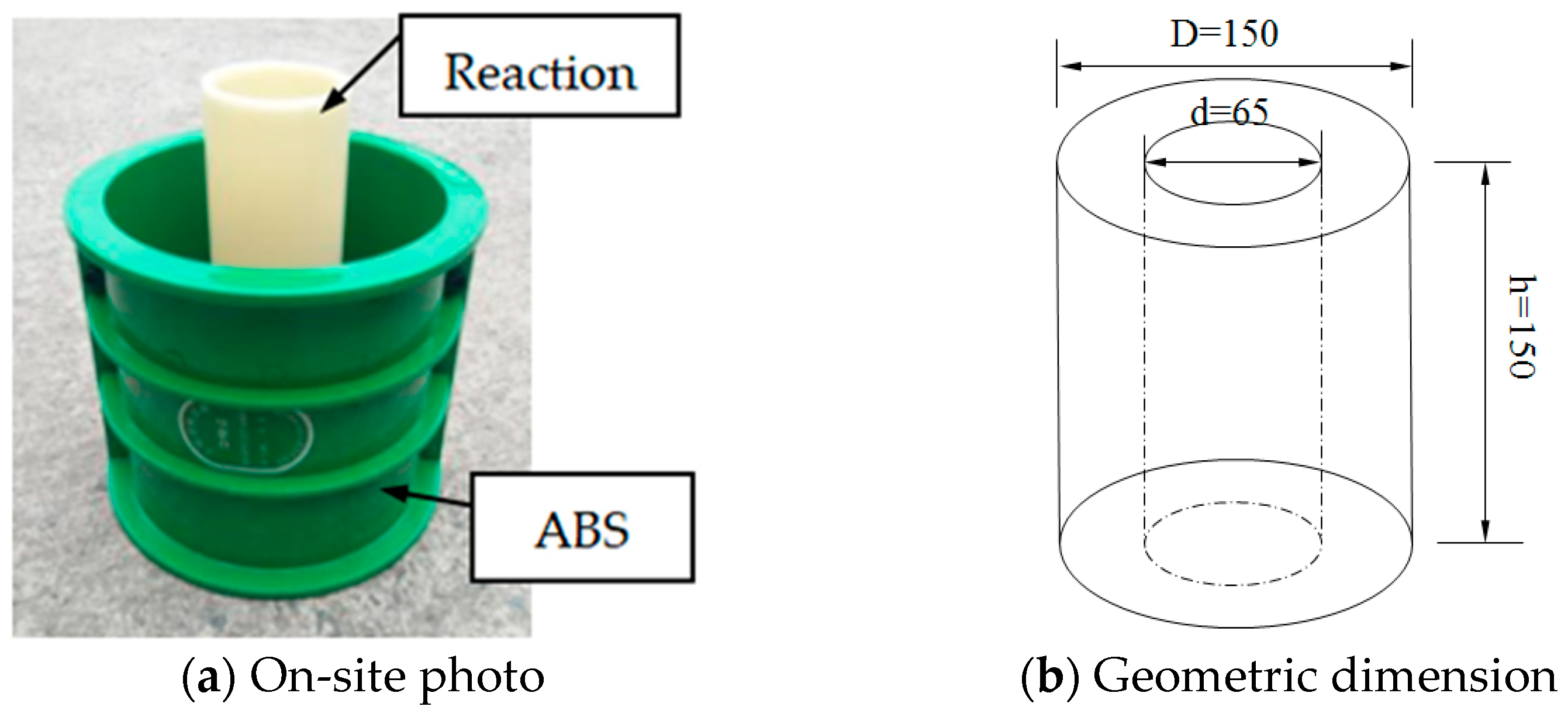
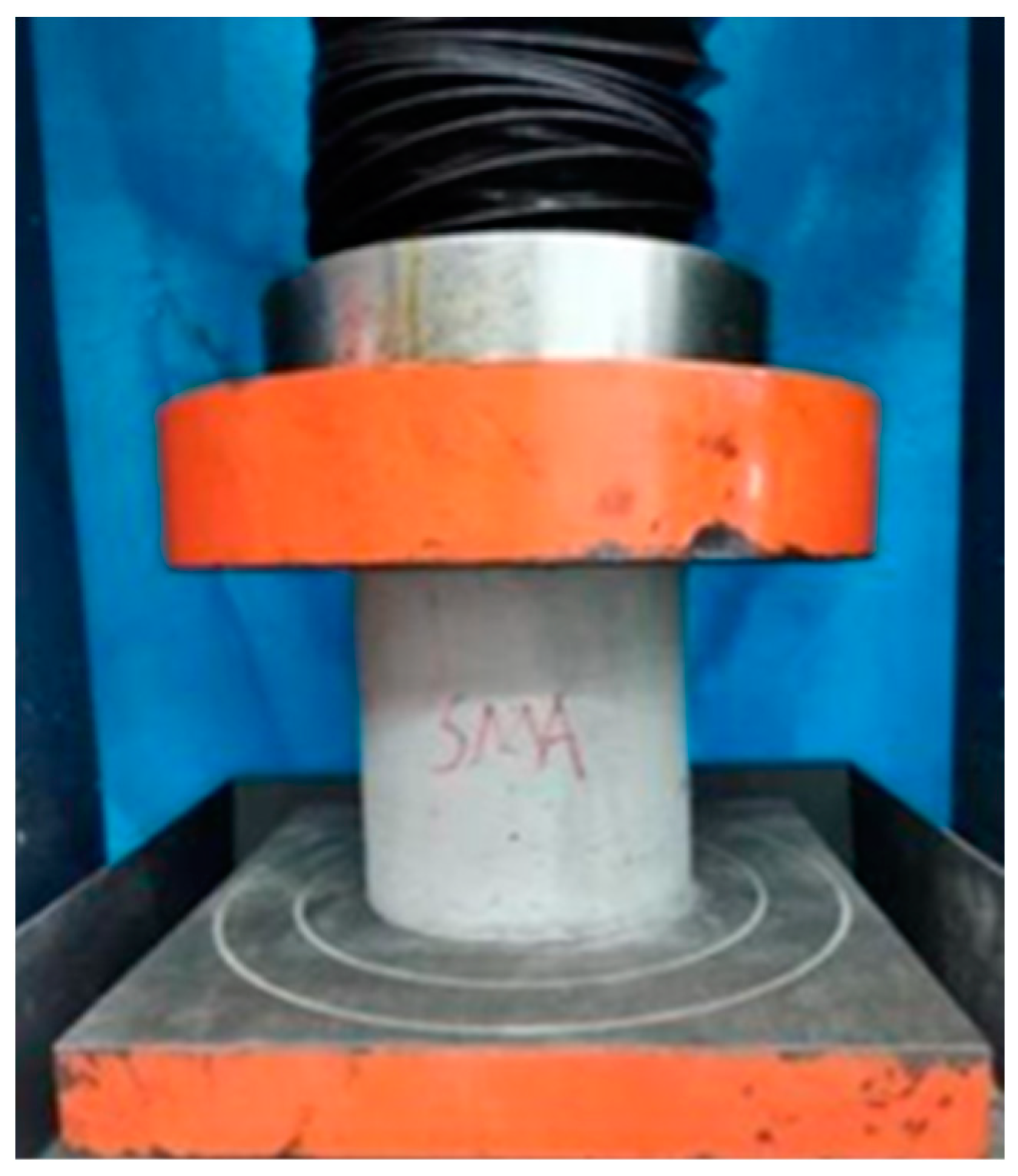

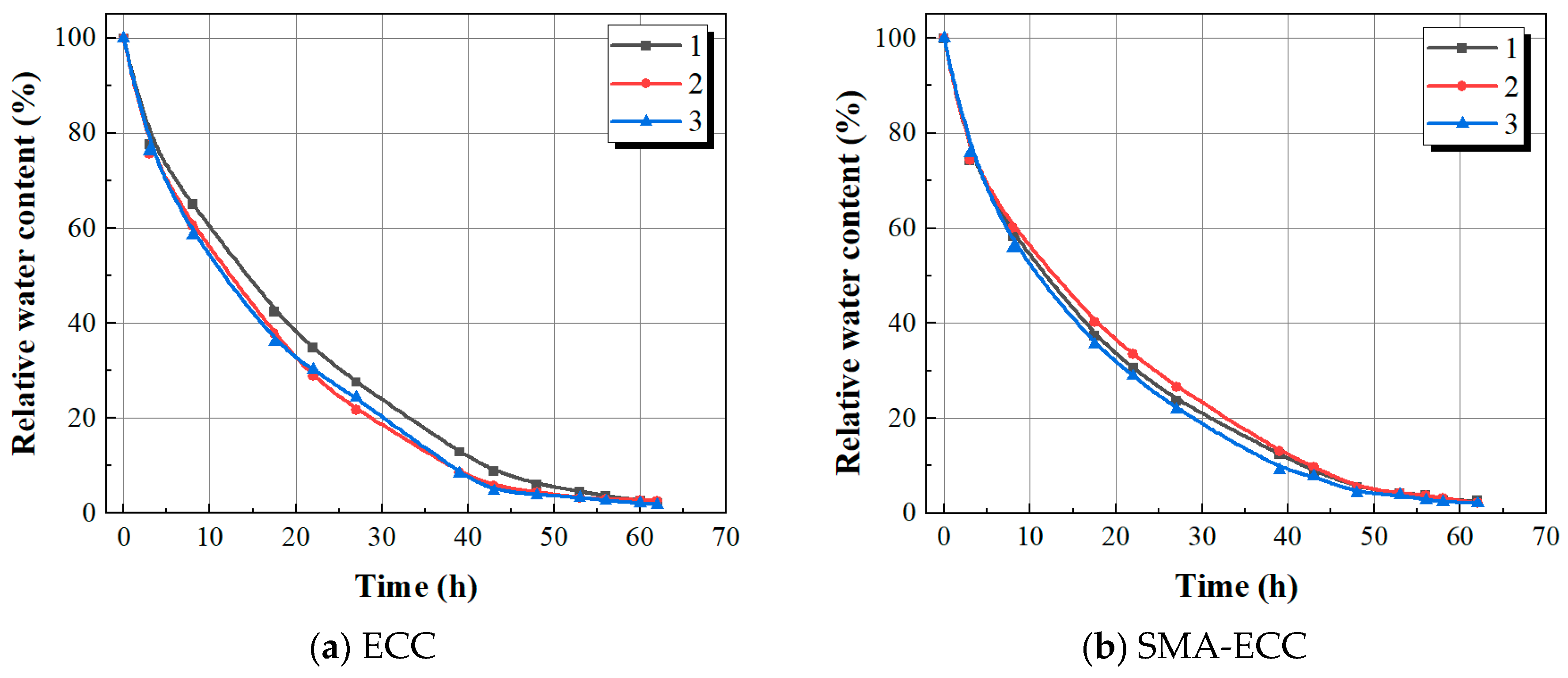
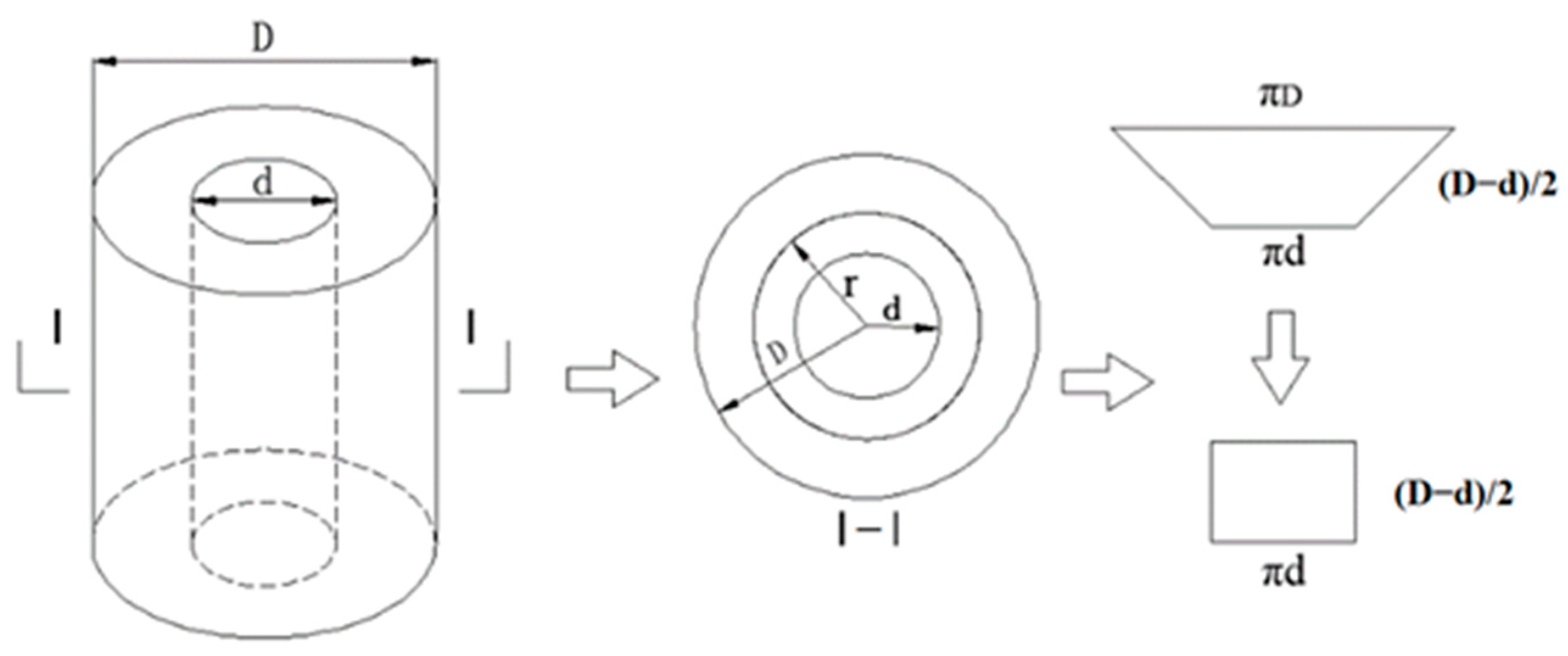
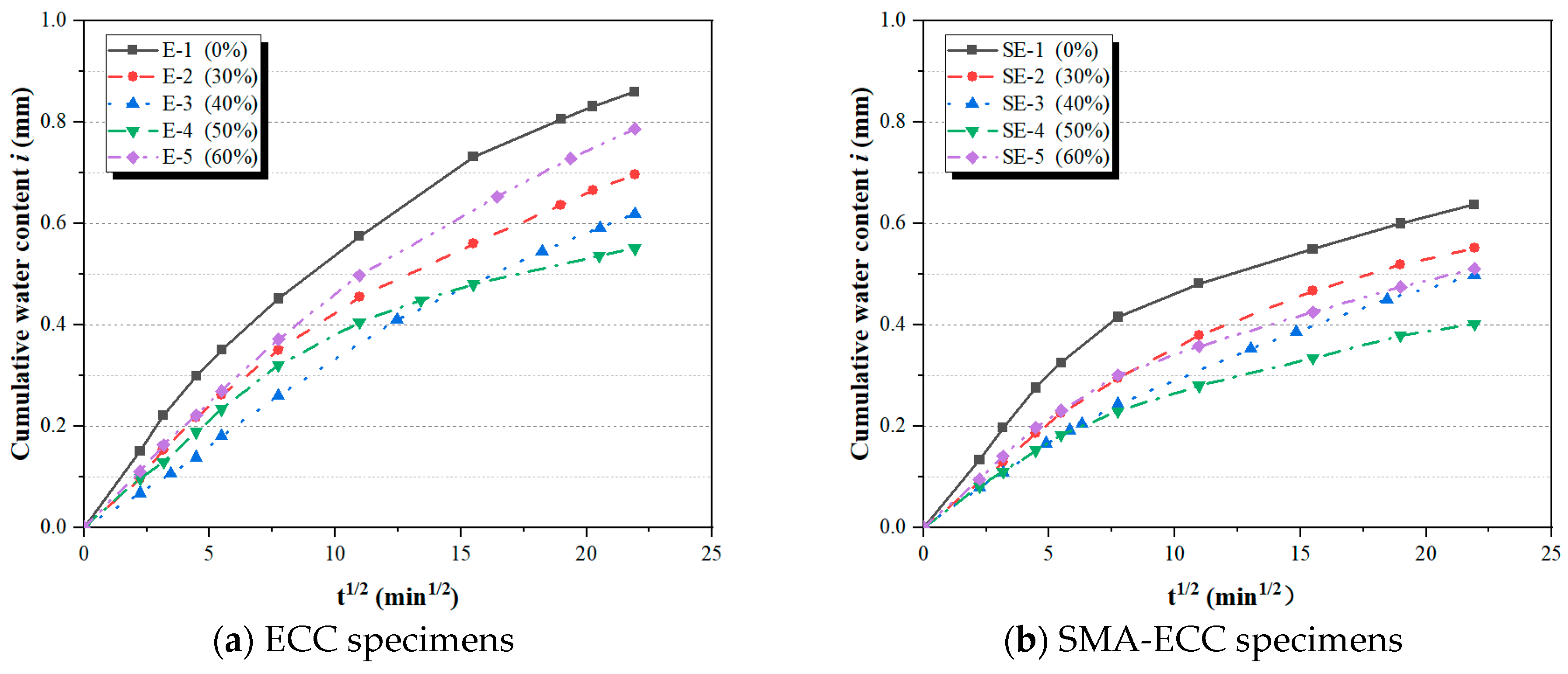

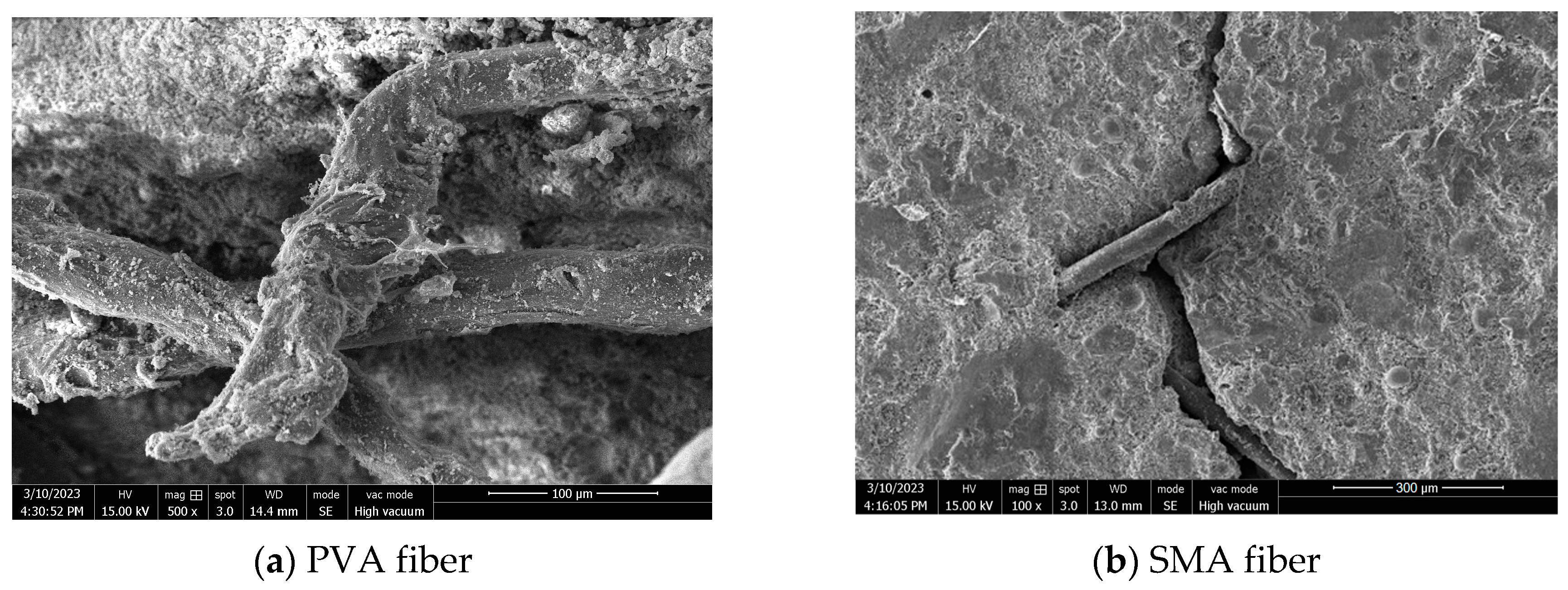
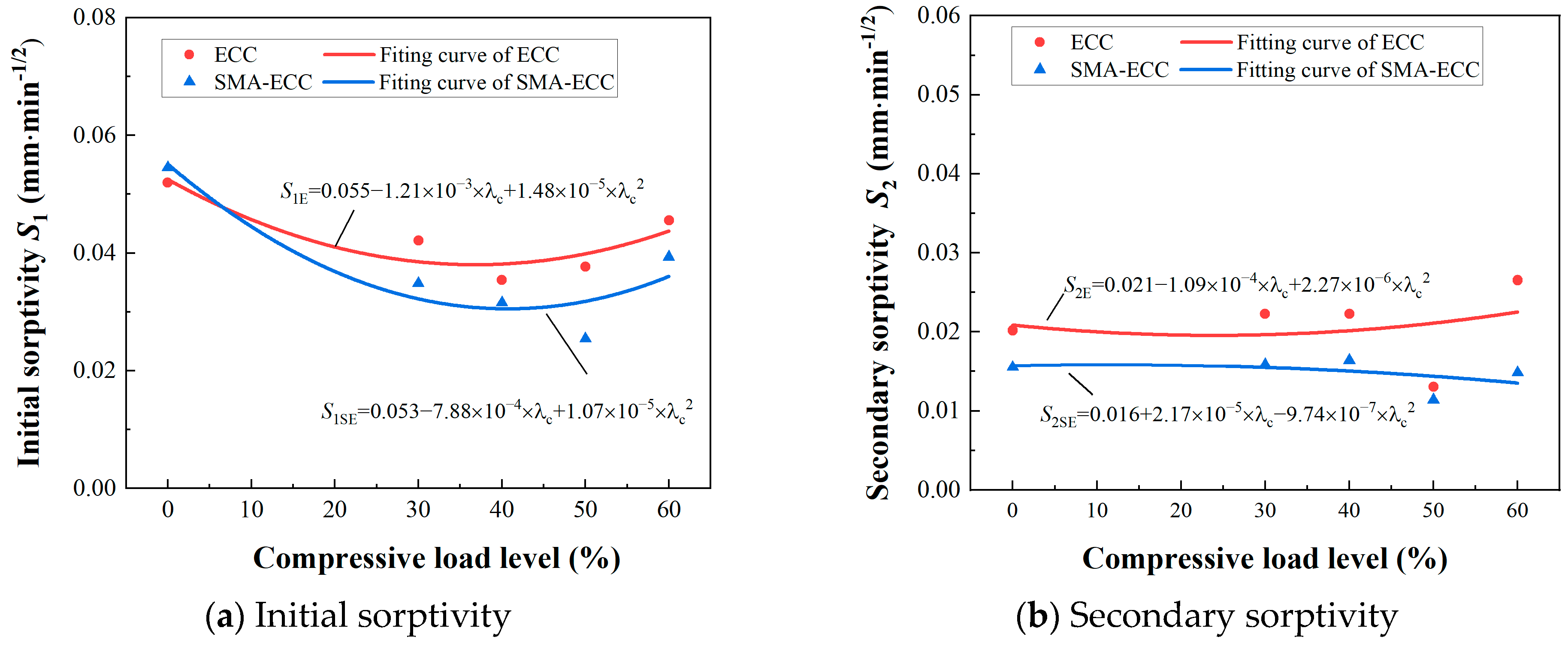
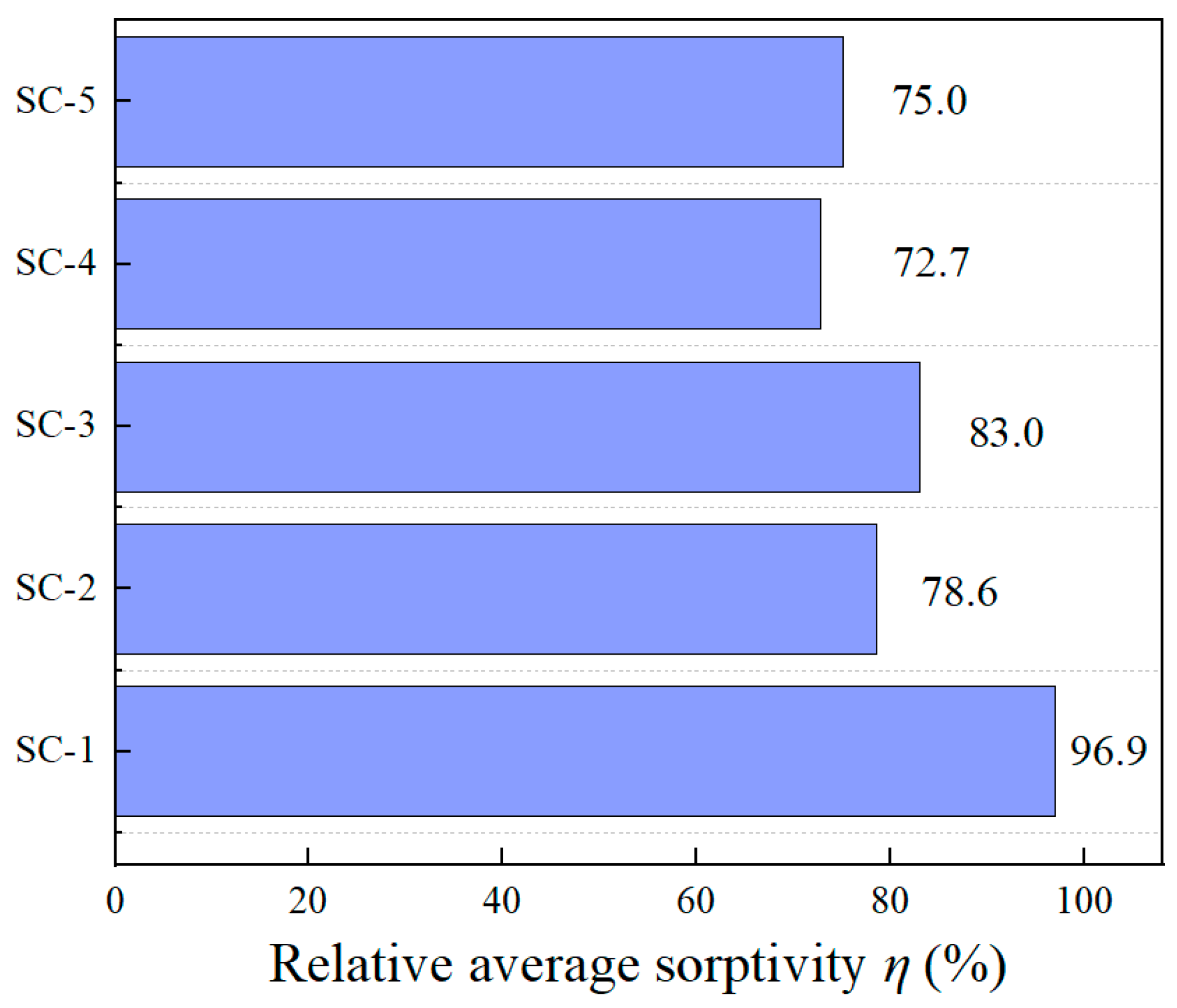
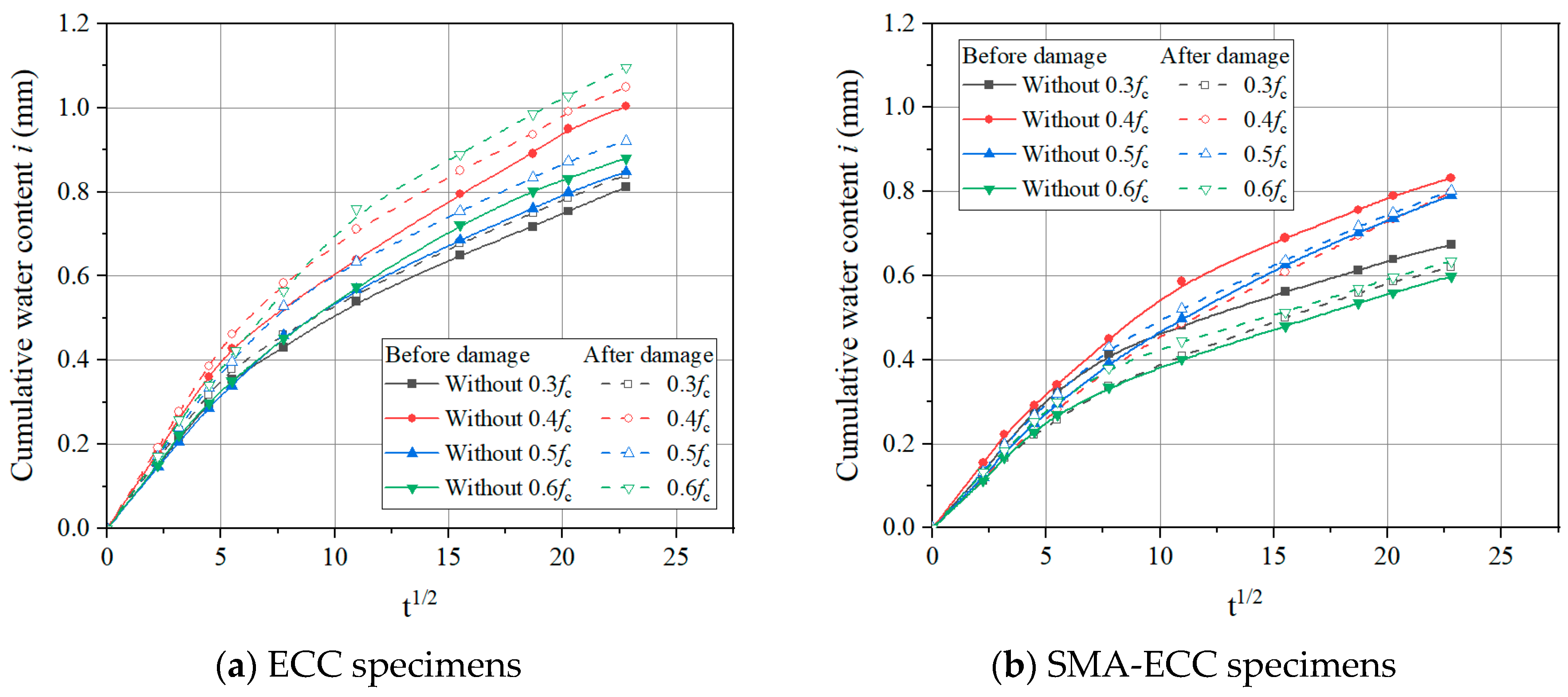
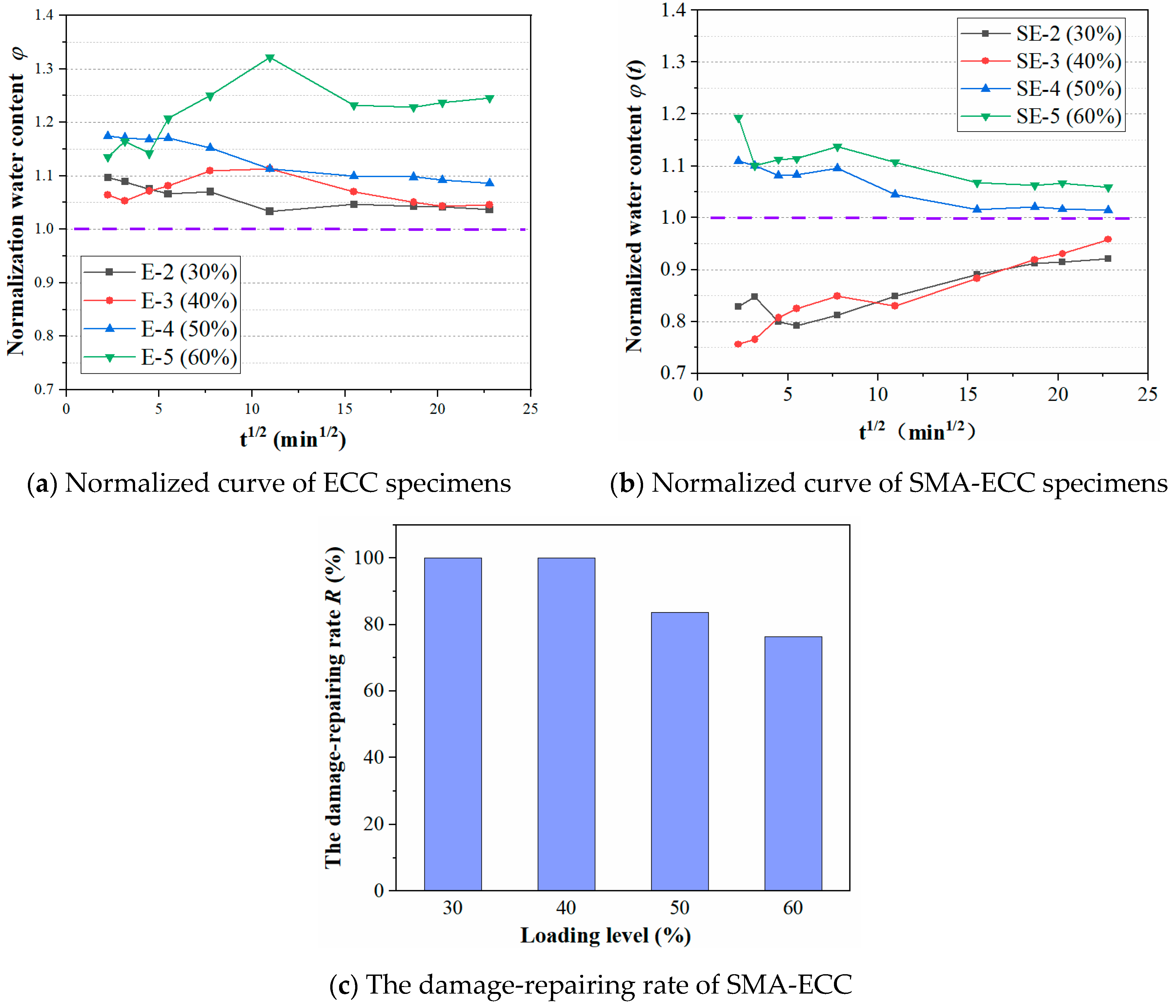
| Cement | Fly Ash | Slag Powder | Silica Sand | Water | HRWRA | PVA (%Vf) | SMA (%Vf) | |
|---|---|---|---|---|---|---|---|---|
| SMA-ECC | 0.3 | 0.55 | 0.15 | 0.4 | 0.25 | 0.002 | 1.7% | 0.7% |
| ECC | 0.3 | 0.55 | 0.15 | 0.4 | 0.25 | 0.002 | 1.7% | - |
| Type | Diameter (mm) | Length (mm) | Tensile Strength (MPa) | Elongation (%) | Young’s Modulus (GPa) | Density (kg/m3) |
|---|---|---|---|---|---|---|
| PVA | 0.04 | 12 | 1560 | 6.5 | 42.8 | 1300 |
| SMA | 0.6 | 16 | 895 | 38.0 | 41.0 | 6450 |
| Materials | Compressive Strength (MPa) | Flexural Strength (MPa) | Elastic Modulus (GPa) | Poisson’s Ratio |
|---|---|---|---|---|
| SMA-ECC | 62.4 | 3.06 | 19.1 | 0.18 |
| ECC | 68.1 | 2.21 | 20.3 | 0.19 |
| Material | Specimen | Loading Levels λc (%) | Applied Stress σc (MPa) | Effective Porosity p (%) |
|---|---|---|---|---|
| SMA-ECC | SE-1 | 0 | 0 | 5.520 |
| SE-2 | 30 | 15.1 | 5.509 | |
| SE-3 | 40 | 20.1 | 5.505 | |
| SE-4 | 50 | 25.2 | 5.501 | |
| SE-5 | 60 | 30.2 | 5.498 | |
| ECC | E-1 | 0 | 0 | 5.640 |
| E-2 | 30 | 16.0 | 5.628 | |
| E-3 | 40 | 21.3 | 5.625 | |
| E-4 | 50 | 26.6 | 5.621 | |
| E-5 | 60 | 31.9 | 5.617 |
Disclaimer/Publisher’s Note: The statements, opinions and data contained in all publications are solely those of the individual author(s) and contributor(s) and not of MDPI and/or the editor(s). MDPI and/or the editor(s) disclaim responsibility for any injury to people or property resulting from any ideas, methods, instructions or products referred to in the content. |
© 2023 by the authors. Licensee MDPI, Basel, Switzerland. This article is an open access article distributed under the terms and conditions of the Creative Commons Attribution (CC BY) license (https://creativecommons.org/licenses/by/4.0/).
Share and Cite
Chen, W.; Han, C.; Liu, Y.; Feng, K.; Zhuang, S. Experimental Investigation of Cumulative Damage and Self-Healing Properties of Smart Cementitious Composite under Continuous Compression Load. Materials 2023, 16, 6090. https://doi.org/10.3390/ma16186090
Chen W, Han C, Liu Y, Feng K, Zhuang S. Experimental Investigation of Cumulative Damage and Self-Healing Properties of Smart Cementitious Composite under Continuous Compression Load. Materials. 2023; 16(18):6090. https://doi.org/10.3390/ma16186090
Chicago/Turabian StyleChen, Weihong, Chunhui Han, Yi Liu, Kai Feng, and Shusen Zhuang. 2023. "Experimental Investigation of Cumulative Damage and Self-Healing Properties of Smart Cementitious Composite under Continuous Compression Load" Materials 16, no. 18: 6090. https://doi.org/10.3390/ma16186090
APA StyleChen, W., Han, C., Liu, Y., Feng, K., & Zhuang, S. (2023). Experimental Investigation of Cumulative Damage and Self-Healing Properties of Smart Cementitious Composite under Continuous Compression Load. Materials, 16(18), 6090. https://doi.org/10.3390/ma16186090





